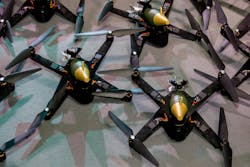Air Force approaches industry for electronic and cyber warfare to counter swarming small uncrewed aircraft
Questions and answers:
- What is the goal of the Air Force’s M-FAT program? Developing technologies to counter small uncrewed aircraft, focusing on electronic warfare (EW), cyber warfare, machine autonomy, small interceptors, and improved communications.
- How will M-FAT address swarming drone attacks? It will use artificial intelligence (AI), machine learning, sensor fusion, and automated decision-making to detect, track, and neutralize swarms, with an emphasis on low-collateral-damage autonomous interceptors.
- What role does cyber warfare play in M-FAT’s strategy? It will integrate cyber warfare with EW to disrupt drone command and control links -- particularly in contested environments -- while minimizing collateral damage.
ROME, N.Y. – U.S. Air Force researchers are asking industry for enabling technologies in countering small uncrewed aircraft through advancements in electronic warfare (EW), cyber warfare, machine automation and autonomy, small interceptors, and communications.
Officials of the Air Force Research Laboratory Information Directorate in Rome, N.Y., issued a broad agency announcement (FA8750-25-S-7004) last week for the Multi-Domain Force Applications and Traffic Management for Unmanned Aircraft Systems (M-FAT) program.
M-FAT seeks research to enhance counter-small unmanned aerial system kill chain and point defense capabilities through advancements in electronic warfare (EW); cyber warfare; command and control automation and autonomy; low-collateral defeat; low-collateral effect interceptors; and communications.
One goal is to blur the line between EW and cyber warfare by developing cyber countermeasures that disrupt small uncrewed aircraft -- particularly command and control links -- in contested environments with an emphasis on low-collateral damage.
Automating uncrewed aircraft defenses
M-FAT seeks to automate how defense forces respond to swarming attacks of small uncrewed aircraft using artificial intelligence (AI), machine learning, sensor fusion, and automated decision-making, leading eventually to affordable and autonomous interceptors with integrated EW, and cyber warfare, and similar counter-uncrewed-aircraft payloads.
The project focuses on improving sensor technologies for enhanced detection, identification, and tracking of small uncrewed aircraft, as well as developing a library for storing and indexing cyber warfare effects.
In parallel, efforts seek to advance uncrewed aircraft traffic management and use them with existing air traffic control for integrating uncrewed aircraft safely into the airspace.
Tell me more about countering swarming small uncrewed aircraft ...
- Countering swarming small uncrewed aircraft involves detection, tracking, identification, and neutralizing. It provides early swarm detection and fast response times; combines radar and infrared sensors; fast sensor networking; AI and machine learning to classify threats, filter out birds and clutter, and predict trajectories; EW and cyber warfare to disrupt swarm communications and control; laser and electromagnetic weapons to attack several enemy drones quickly without running out of ammunition; and kinetic weapons like autocannons and airburst munitions; barriers like nets and tethers.
Communications also should be improved using advanced modeling and simulation, resilient waveforms and networking swarm operations, using AI for network and spectrum management.
Companies interested should email white papers no later than 4 Aug. 2030 to the Air Force's Tristen Carrig at [email protected] and Peter Fitzgerald at [email protected].
Email questions or concerns to Tristen Carrig at [email protected] and Peter Fitzgerald at [email protected], and include a reference to FA8750-25-S-7004 and Multi-Domain Force Applications and Traffic Management for Unmanned Aircraft Systems (M-FAT). More information is online at https://sam.gov/opp/fc921bfba19241039572908fc7296c72/view.
About the Author
John Keller
Editor-in-Chief
John Keller is the Editor-in-Chief, Military & Aerospace Electronics Magazine--provides extensive coverage and analysis of enabling electronics and optoelectronic technologies in military, space and commercial aviation applications. John has been a member of the Military & Aerospace Electronics staff since 1989 and chief editor since 1995.
